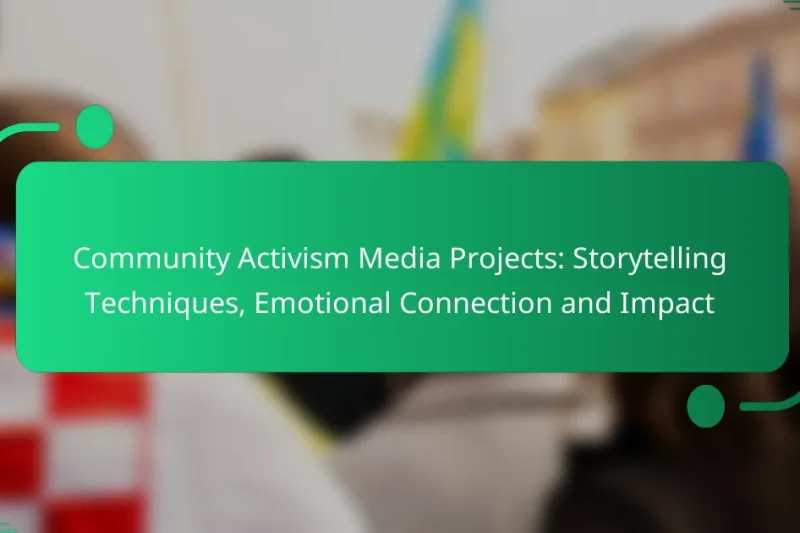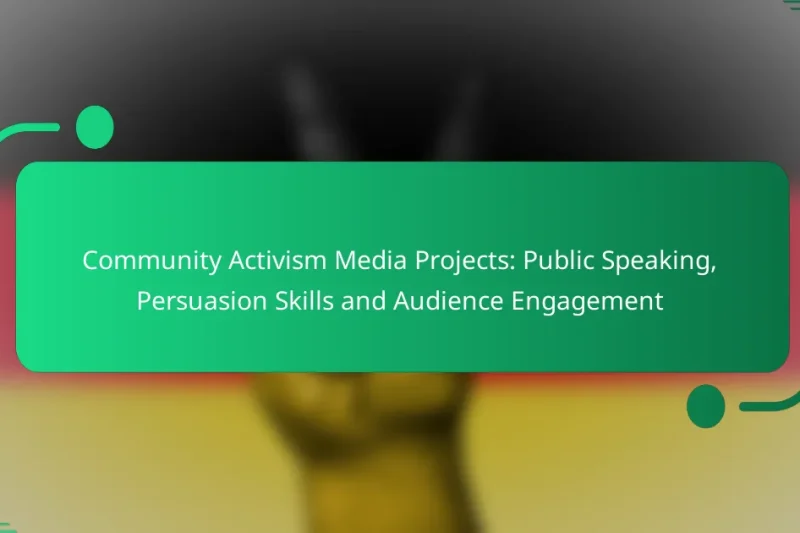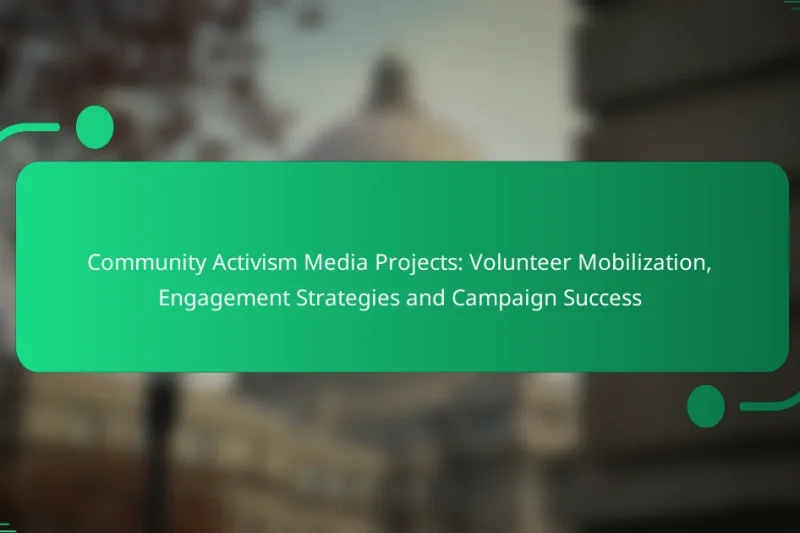Community activism media projects leverage the power of storytelling to create emotional connections that resonate deeply … Community Activism Media Projects: Storytelling Techniques, Emotional Connection and ImpactRead more
Community Activism Media Projects: Advocacy Techniques
Community activism media projects play a crucial role in enhancing advocacy efforts by amplifying voices and raising awareness for various causes. By utilizing effective techniques such as grassroots mobilization and digital campaigning, these projects foster engagement and influence decision-makers. With the right tools and strategies, communities can share their narratives and connect with wider audiences, ultimately driving meaningful change.
Community Activism Media Projects: Public Speaking, Persuasion Skills and Audience Engagement
Community activism media projects offer valuable opportunities to enhance public speaking and persuasion skills, enabling participants … Community Activism Media Projects: Public Speaking, Persuasion Skills and Audience EngagementRead more
Community Activism Media Projects: Traditional Techniques, Digital Strategies and Effectiveness
Community activism media projects thrive on a blend of traditional techniques and digital strategies, each offering … Community Activism Media Projects: Traditional Techniques, Digital Strategies and EffectivenessRead more
Community Activism Media Projects: Advocacy Materials, Outreach Strategies and Community Impact
Community activism media projects play a crucial role in enhancing advocacy efforts by raising awareness and … Community Activism Media Projects: Advocacy Materials, Outreach Strategies and Community ImpactRead more
Community Activism Media Projects: Compelling Messages, Campaign Strategies and Audience Engagement
Community activism media projects play a crucial role in delivering compelling messages that resonate with audiences … Community Activism Media Projects: Compelling Messages, Campaign Strategies and Audience EngagementRead more
Community Activism Media Projects: Volunteer Mobilization, Engagement Strategies and Campaign Success
Community activism media projects play a crucial role in mobilizing volunteers by employing targeted engagement strategies … Community Activism Media Projects: Volunteer Mobilization, Engagement Strategies and Campaign SuccessRead more
How can media projects enhance community activism in the United States?
Media projects can significantly boost community activism in the United States by amplifying voices, raising awareness, and mobilizing support for various causes. They create platforms for storytelling and engagement, allowing communities to share their narratives and connect with broader audiences.
Engagement through storytelling
Storytelling is a powerful tool in community activism, as it humanizes issues and fosters empathy. By sharing personal experiences, activists can illustrate the impact of social challenges, making them relatable and urgent to the audience. For instance, a local campaign addressing homelessness might feature video testimonials from affected individuals, highlighting their struggles and resilience.
To effectively engage through storytelling, focus on authenticity and emotional resonance. Use diverse formats such as written articles, podcasts, or short films to reach different demographics. Aim for narratives that not only inform but also inspire action, encouraging viewers to participate in advocacy efforts.
Utilizing social media platforms
Social media platforms are essential for enhancing community activism by providing a space for rapid information sharing and mobilization. Platforms like Facebook, Twitter, and Instagram allow activists to reach large audiences quickly, disseminating updates, event information, and calls to action. For example, a grassroots movement can use hashtags to unify messaging and increase visibility.
When using social media, consistency and engagement are key. Regularly post updates and interact with followers to build a supportive community. Be mindful of platform algorithms; using engaging visuals and concise messaging can improve reach and impact. Avoid misinformation by verifying sources before sharing content.
Collaborative content creation
Collaborative content creation involves working with community members to produce media that reflects their perspectives and needs. This approach not only empowers individuals but also fosters a sense of ownership over the activism process. Workshops or brainstorming sessions can be effective in generating ideas and content collaboratively.
To implement collaborative content creation, consider forming partnerships with local organizations or schools. This can lead to diverse content, such as community blogs, joint videos, or art projects that highlight local issues. Ensure that all voices are heard and represented, which can strengthen community ties and enhance the overall impact of the activism efforts.
What advocacy techniques are effective for community media projects?
Effective advocacy techniques for community media projects include grassroots mobilization, digital campaigning, and public relations strategies. These methods help raise awareness, engage the community, and influence decision-makers to support specific causes.
Grassroots mobilization strategies
Grassroots mobilization strategies focus on engaging local community members to advocate for change. This can involve organizing events, rallies, or community meetings to raise awareness and gather support. Utilizing local networks and social connections is crucial for building momentum.
Consider forming coalitions with other local organizations to amplify your efforts. Sharing resources and collaborating on campaigns can enhance visibility and effectiveness. Always ensure that your messaging resonates with the community’s values and needs.
Digital campaigning methods
Digital campaigning methods leverage online platforms to reach a broader audience. Social media, email newsletters, and websites are essential tools for disseminating information and mobilizing supporters. Creating engaging content, such as videos and infographics, can help capture attention and encourage sharing.
Utilize targeted advertising on platforms like Facebook or Instagram to reach specific demographics. Monitor engagement metrics to assess the effectiveness of your campaigns and adjust your strategies accordingly. Remember to maintain a consistent message across all digital channels.
Public relations tactics
Public relations tactics involve managing the public perception of your community media project. This includes crafting press releases, engaging with journalists, and building relationships with media outlets. A well-timed press release can generate significant coverage and support for your cause.
Consider hosting press events or media briefings to share important updates and achievements. Always be prepared with clear, concise messaging that highlights the impact of your project. Building a positive reputation can lead to increased support and resources for future initiatives.
Which tools support community activism media projects?
Community activism media projects benefit from a variety of tools that enhance communication, design, and outreach. Key tools include graphic design software, social media management platforms, and virtual meeting applications, each serving distinct purposes to amplify advocacy efforts.
Canva for graphic design
Canva is a user-friendly graphic design tool that allows activists to create visually appealing materials without needing extensive design skills. It offers a wide range of templates for social media posts, flyers, and infographics, making it easy to produce professional-looking content quickly.
When using Canva, consider the importance of branding. Consistent use of colors, fonts, and logos can strengthen your message. Aim for simplicity and clarity in your designs to ensure your audience understands the key points at a glance.
Hootsuite for social media management
Hootsuite is an effective social media management tool that helps activists schedule posts, track engagement, and analyze performance across multiple platforms. This can save time and ensure a consistent online presence, which is crucial for maintaining momentum in advocacy campaigns.
To maximize Hootsuite’s potential, create a content calendar that outlines your posting schedule and key messages. Monitor engagement metrics to adjust your strategy based on what resonates most with your audience, ensuring your advocacy efforts remain impactful.
Zoom for virtual meetings
Zoom is a widely used platform for virtual meetings, allowing activists to connect with team members and supporters regardless of location. Its features, such as screen sharing and breakout rooms, facilitate collaboration and discussion, making it ideal for organizing campaigns or training sessions.
When using Zoom, ensure you have a stable internet connection and familiarize yourself with the platform’s features beforehand. Setting clear agendas for meetings can help keep discussions focused and productive, ultimately leading to more effective activism outcomes.
What are the key metrics for measuring success in activism media?
Key metrics for measuring success in activism media include engagement rates on social media, community participation levels, and media coverage frequency. These indicators help assess the effectiveness of advocacy efforts and the impact on the target audience.
Engagement rates on social media
Engagement rates on social media reflect how actively users interact with content related to activism. This includes likes, shares, comments, and overall reach. A high engagement rate, typically above 2-3%, indicates that the content resonates with the audience.
To improve engagement, consider using compelling visuals, asking questions, and encouraging user-generated content. Monitoring engagement trends over time can help identify which types of posts are most effective.
Community participation levels
Community participation levels measure how many individuals actively take part in activism initiatives, such as events, meetings, or campaigns. This can be quantified through attendance numbers or participation in surveys and feedback sessions. A strong participation level often signifies a well-connected community.
To boost participation, create inclusive events that cater to diverse community interests and ensure accessibility. Tracking attendance and collecting feedback can provide insights into community needs and preferences.
Media coverage frequency
Media coverage frequency indicates how often activism efforts are reported in local or national media. This can include news articles, interviews, or features. Regular media coverage can enhance visibility and credibility, helping to attract more supporters.
To increase media coverage, develop strong relationships with journalists and provide them with clear, newsworthy stories. Creating press releases and media kits can also facilitate better communication with the press.
How do partnerships enhance community activism media projects?
Partnerships significantly enhance community activism media projects by pooling resources, expertise, and networks. Collaborating with various stakeholders can amplify outreach efforts and create a more impactful message.
Collaboration with local organizations
Working with local organizations allows media projects to tap into established community trust and knowledge. These organizations often have deep insights into the issues at hand and can provide valuable data and support.
For effective collaboration, identify organizations that align with your project goals. Establish clear communication channels and set mutual objectives to ensure a successful partnership.
Support from educational institutions
Educational institutions can offer research support, access to students, and facilities for events. Collaborating with universities or colleges can enhance the credibility of a media project and attract a younger audience.
Consider hosting workshops or seminars in partnership with these institutions to engage students and faculty. This can also lead to internship opportunities for students, benefiting both parties.
Engagement with local businesses
Local businesses can provide financial support, resources, or promotional assistance for community activism media projects. Engaging them can foster a sense of community ownership and responsibility towards local issues.
To effectively engage businesses, present a clear value proposition. Highlight how their involvement can improve their public image and strengthen community ties. Consider offering sponsorship packages or co-hosting events to maximize benefits.
What challenges do community activism media projects face?
Community activism media projects often encounter obstacles such as limited funding, lack of audience engagement, and difficulties in reaching diverse demographics. These challenges can hinder their effectiveness in advocating for social change and raising awareness about critical issues.
Funding and Resource Limitations
Securing adequate funding is a significant challenge for community activism media projects. Many rely on grants, donations, or crowdfunding, which can be unpredictable. It’s essential to create a detailed budget and explore multiple funding sources to ensure sustainability.
Resource limitations can also affect the quality of media output. Projects may need to prioritize essential tools and platforms, focusing on cost-effective solutions like social media or community radio to maximize outreach.
Engagement and Audience Reach
Engaging the target audience is crucial for the success of activism media projects. Many initiatives struggle to capture attention in a crowded media landscape. Utilizing storytelling techniques and relatable content can help resonate with the community and foster participation.
To improve audience reach, projects should consider partnerships with local organizations and influencers. Collaborating with established entities can enhance credibility and expand visibility within the community.
Diversity and Inclusion Challenges
Community activism media projects must address the diverse needs of their audience to be effective. Often, projects may unintentionally exclude certain groups due to language barriers, cultural differences, or accessibility issues. Conducting thorough community assessments can help identify these gaps.
Incorporating feedback from various community members can also enhance inclusivity. Projects should strive to represent a wide range of voices and perspectives, ensuring that all demographics feel valued and heard.





